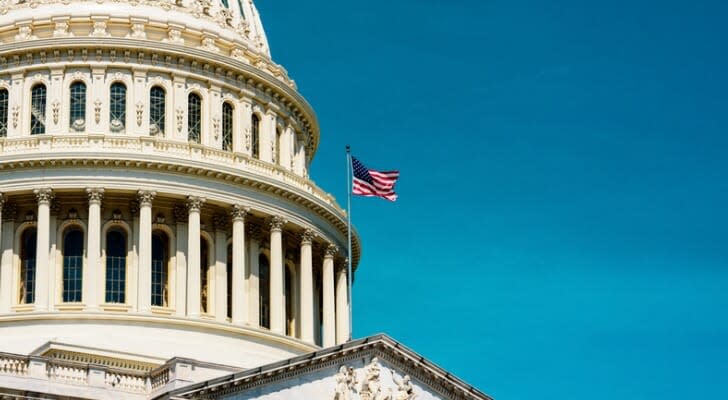Social Security Funds Could Run Dry by 2035

The Social Security Administration now says the funds Social Security uses to pay benefits will run dry by 2035, one year later than previously predicted. For most Americans those extra 12 months are cold comfort. Will Congress come to the rescue? There’s a bill in the House of Representatives that could make some difference, but even if it becomes law, that might not be enough to sustain the program at its current level of benefits. Here are some things you can do to prepare for 2035 if Washington doesn’t rise to the challenge.
Consider working with a financial advisor as you plan your retirement.
A Looming Crunch?
Social Security is a vital retirement component for 66 million beneficiaries and 182 million workers and families in 2022. The combined asset reserves of the Old-Age & Survivors Insurance and Disability Insurance (OASI) Trust Funds will run out in 2035, the Social Security Administration (SSA) said in early June 2022. That’s one year later than the SSA’s 2021 projection and still leaves people in their 50s and older with legitimate concerns.
Specifically, the Old-Age & Survivors Insurance Trust Fund is projected to become depleted in 2034, one year later than last year’s estimate, with 77% of benefits payable at that time. On the other hand, the Disability Insurance Trust Fund asset reserves are not currently projected to become depleted until near the end of this century. The estimate of the benefits dropping to 80% in 2035 assumes that the law will have been changed to permit the transfer of funds between OASI and DI as needed, the SSA report said.
Besides the projected 20% reduction of benefits in 2035, the SSA said that if no legislative fixes become law by 2095, there will only be enough to pay 74% of scheduled benefits at that time.
The table below provides estimates of currently projected Social Security benefits for a range of unmarried recipients, listed by birth year, with a $100,000 yearly income and a retirement at age 66. It also shows what 80% of the projected benefits would be and what has to be made up.
What a 20% Cut in Social Security Benefits Could Look Like Birth Year of Recipient Estimated Yearly Benefit 80% of Benefit The Difference 1957 $34,333 $27,466 $6,867 1962 $38,767 $31,014 $7,753 1967 $41,617 $33,294 $8,323 1972 $44,424 $35,539 $8,885 1977 $47,553 $38,042 $9,511 1982 $51,390 $41,112 $10,278 1987 $55,818 $44,654 $11,164 1992 $60,643 $48,514 $12,129
Increasing the size of your nest egg to compensate for a 20% reduction in your Social Security benefit will likely require a six-figure increase in your portfolio. For example, a $100,000 portfolio with a 6% per year gain will give you $6,000 annually. But if you want $12,000 per year, you would need $200,000 (assuming that same 6% per year gain in your portfolio).
A Congressional Attempt at a Solution
Rep. John B. Larson (D-Conn.), who is chairman of the House Ways and Means Social Security Subcommittee, has introduced Social Security 2100: A Sacred Trust, a bill that aims to strengthen the trust funds by raising taxes on high earners and makes up more than half the estimated shortfall in the Social Security Trust Funds. It also expands benefits in a number of ways, including the following four:
-
Provides an increase for all beneficiaries (receiving retirement, disability or dependent benefits) equivalent to an average of 2% of benefits to make up for inadequate cost-of-living adjustments since 1983.
-
Improves the annual cost-of-living adjustment formula to better reflect the costs incurred by seniors through adopting what’s called a “CPI-E formula.”
-
Raises the minimum benefit to 25% above the poverty line and ties it to wage levels to ensure that the minimum benefit does not fall behind.
-
Repeals the windfall elimination provision and government pension offset that currently reduces Social Security benefits for many government employees.
The response among some interest groups has not been positive. The Committee for a Responsible Budget slammed Larson’s measure as a step backwards. The “bill is a substantial downgrade from 2019’s Social Security 2100 Act, which we’ve praised as a responsible solution to Social Security’s financial troubles. Whereas [Social Security 2100 Act] would have restored the program to sustainable solvency, A Sacred Trust would close half the solvency gap on paper and would actually worsen solvency once gimmicks are removed.”
What You Should Consider Doing
There are a number of steps you can take to get that six-figure boost in your portfolio and make sure 2035 doesn’t hit you in the pocketbook. Here are four of those steps.
Consider a higher risk portfolio. A higher risk investment may offer correspondingly higher returns to offset the downside posed by its risks. The prospect of enhanced returns are what draw some investors in, even as the risk will deter others. By contrast, a lower risk investment can offer relatively low rates of return, as the safety of this investment is what draws investors in. When planning your investments, you will need to determine how much risk you want to take on. This guide will help you figure out your risk tolerance.
Focus on tax alpha. The tax efficiency of your portfolio is a sometimes overlooked consideration in financial planning and in assessing your investment’s total return. But not paying any more than you need to in taxes can have an outsize effect on your eventual net worth. That’s especially the case now for reasons described below. What follows are several ways – both strategic and tactical – to boost your portfolio’s so-called tax alpha. After all, it doesn’t do much good to invest successfully if you’re paying unnecessary taxes. A successful retirement is as much about what you get to keep as how well your investments do.
Cut spending. Take a look at your spending, both discretionary and non-discretionary. Discretionary spending is spending for things that you don’t need, such as a vacation, a new wardrobe, a fancier digital device or eating out at restaurants. There’s usually room to cut. Non-discretionary spending is spending on necessities. These include food, beverages, rent or mortgage payments, utilities, medical care and taxes. These are more difficult to trim than discretionary spending. That is part of the reason many retired Americans or those contemplating retirement move to states with lower taxes.
Work longer. During your working years you developed valuable skills and acquired marketable knowledge. After you retire, you finally have the chance to use those skills and knowledge in a way that is fulfilling to you. But keep your overall retirement plan in mind: Don’t make a mistake with Medicare or Social Security. If you have one or more tax-advantaged accounts, schedule withdrawals carefully.
Bottom Line
The latest news from the Social Security Administration about depleting funds to pay benefits lasting to 2035 instead of to 2034 indicates how important this issue is. Congress may or may not fix the funding issue in the next 13 years. However, it would be wise for private citizens to take such steps as they are able to help ensure a fully funded retirement.
Tips on Retirement
-
Creating a solid retirement plan can get complicated. That’s why the insights and guidance of a financial advisor can make a significant difference in your retirement. Finding a qualified financial advisor doesn’t have to be hard. SmartAsset’s free tool matches you with up to three financial advisors who serve your area, and you can interview your advisor matches at no cost to decide which one is right for you. If you’re ready to find an advisor who can help you achieve your financial goals, get started now.
-
Are you saving enough for retirement? SmartAsset’s award-winning calculator can help you determine exactly how much you need to save to retire.
Don’t miss out on news that could impact your finances. Get news and tips to make smarter financial decisions with SmartAsset’s semi-weekly email. It’s 100% free and you can unsubscribe at any time. Sign up today.
For important disclosures regarding SmartAsset, please click here.
Photo credit: ©iStock.com/Kameleon007, ©iStock.com/YayaErnst, ©iStock.com/Wasan Tita
The post Social Security Funds to Run Dry by 2035? Here’s How to Prepare appeared first on SmartAsset Blog.
Share this news on your Fb,Twitter and Whatsapp
Times News Network:Latest News Headlines
Times News Network||Health||







